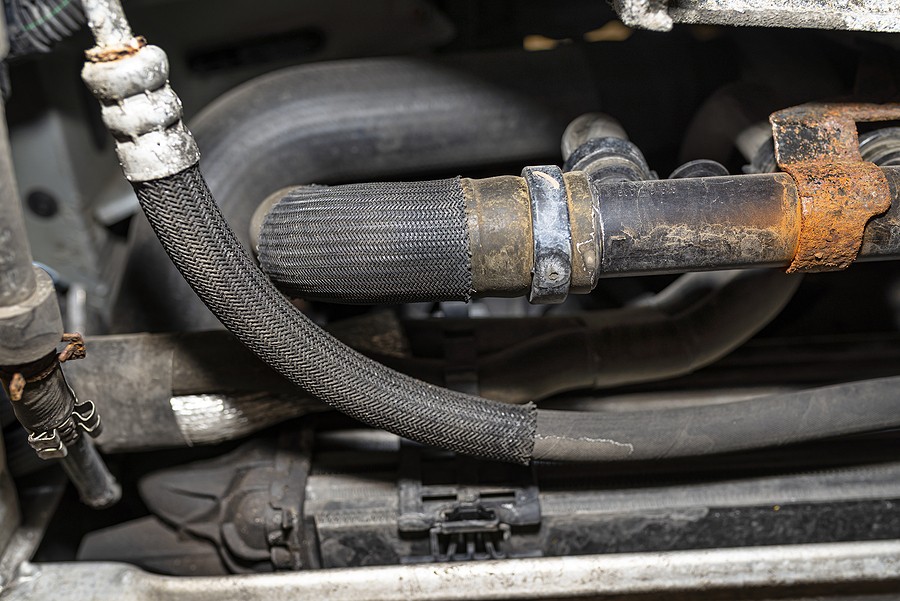
Stick the tape on the hose making sure to cover the hole. Begin by identifying the leaking radiator hose that needs to be replaced.
Be advised that any roadside repair should be treated as temporary.
How to repair a radiator hose. How to Repair a Radiator Hose. Before you can replace the radiator hose you need to drain your cooling system. Make sure the car is turned off and that.
Remove the Radiator Hose. Once the system is drained of coolant simply remove the old hose and install the new one. The hose may be attached with a spring clamp or band clamp.
Either way make sure you inspect the old clamp and replace it if it is rusty or weak along with your new hose. Begin by identifying the leaking radiator hose that needs to be replaced. Do this by running the car to operating.
Drain the engine coolant when it has cooled. Open the petcock on the lower end of the radiator and drain it into a. Loosen the clamps on the leaking radiator hose.
How to Fix a Cracked Radiator Hose Step 1. Open the hood and examine the radiator hoses. Determine the source of the leak.
For example the clamps that. Turn off the engine and let it cool down for 30 minutes. Tighten the radiator clamps with a screwdriver.
If the clamp has been. If the cap has a pressure-release flap thats released your engine may have only overheated but if the cap is intact and you can see a leak in the heater hose youll be able to fix it. Once the engine is cool remove the radiator cap.
Put the cap back on after the fix. First take off the radiator cap then drain the coolant. Loosen the hose clamps and remove the hose.
Then attach the new hose and refill the radiator. Be advised that any roadside repair should be treated as temporary. And a hole in a radiator hose usually indicates a bigger problem may be going on inside your engine.
How to Repair a Broken Hose Connection on a Plastic Radiator Step 1. Disconnect the hoses from the radiator after allowing the vehicle to cool down. Unscrew the metal rings.
After allowing the coolant to flow from the radiator remove the radiator from the vehicle. The removal of the. Learn to spot the signs of a radiator leak and how to seal a leak.
This is our step-by-step guide on how to fix a radiator leak at home or on the road. Signs of a Radiator Leak. First its important to check for signs of a leaking radiator.
A small leak may be difficult to notice at first but a major leak should be easy to identify. The upper radiator hose carries hot coolant from the thermostat housing on the engine to the radiator inlet. After the coolant passes through the radiator and sheds excess heat the coolant exits the bottom of the radiator into the lower radiator hose bringing the cooled fluid back to the engine.
Tear a piece of duct tape long enough to wrap around the hose about 4 to 6 inches long. Stick the tape on the hose making sure to cover the hole. Step 5 Reinforce the taped section of the hose by wrapping another piece of tape on either side of the first piece.
Wash the radiator with a hose. It will be much easier to locate the leak in your radiator after its clean of old grime and coolant. Use a hose to spray the radiator and surrounding components so you can know for sure that any new coolant you see in the engine bay after you start the car has leaked since you washed it.
Here is how you should go about repairing a damaged radiator hose Honda. Determine the location of the leakdamage Ensure the engine hose and radiator fluid have cooled then remove the radiator filler cap to relieve pressure from the cooling system. Use a flat head screwdriver to remove the hose clamps on both ends of the hose.
You may have to use a utility knife to remove the hose completely. If so remember to cut carefully so you dont damage the radiator. Put the hose clamps on to the new radiator hose and put it in proper position.
Tighten the hose clamps. With a hot water system water must be drained from the radiator. Turn down the thermostat.
Attach a hose to the boilers drain valve and run the hose to a floor drain. Open the valve to drain the system. Starting at the top floor of your house open the bleeder valves of all radiators.
First place a piece of cardboard underneath your car and leave it there overnight. Take a look at the cardboard in the morning to determine a rough estimate of the location of the car coolant leak. Then open the hood and look for signs of the leak.
Check the radiator hose and clamps for signs of wetness.
